If Canadians think about defence at all it is often couched in terms of how we have been blessed by geography and by having, most of the time, a very good neighbour to the south. It does not occur to most of us that ‘the longest undefended border’ arguably might be to our north. Draw a line along our ‘Northern Shore’, from the Alaskan border east, then north along the islands almost to the North Pole, then south and east, and then south again, to the perhaps appropriately named Battle Harbour in Newfoundland and Labrador, and you’ll see how long that border is.
Why should this be important to us? During the Second World War, because of a single Japanese submarine shelling Estevan Point lighthouse on Vancouver Island, about one-third of Canada’s infantry soldiers remained on the West Coast defending against a possible Japanese invasion while, from D-Day until the war’s end, infantry units in Europe were bleeding out, begging for reinforcements. Maintaining troops on the West Coast was all about allaying fear, showing that the military could do something concrete, but at that point in the conflict there was no credible military threat from Japan. Today we are increasing our NATO commitment in Latvia. If those troops were committed to combat operations how many reinforcements would they receive if an aggressor made an incursion on Canadian soil? The reaction to such an incursion would be a major distraction, because public, media and politicians, just like in the mid-1940s, would demand action, this time to secure our beloved but often-ignored North.
The 18th century French writer Voltaire famously said that no adversary would want a “few acres of snow” in Canada. But our North is more than a few acres of snow. There are population centres, citizens, infrastructure, resources. And amongst all this some strategic targets an aggressor might covet. One example: Canadian Forces Station (CFS) Alert is as far north as Canadians can get, the top end of Ellesmere Island. According to its open source Royal Canadian Air Force website “CFS Alert maintains signals intelligence facilities to support Canadian military operations”. Given its location, no need to guess whose signals they are collecting. If Russia was about to embark on another European adventure would it make sense they ensure we, and thus NATO, couldn’t eavesdrop on Russian plans and shift NATO forces to respond?
There are few soldiers in CFS Alert. A significant number are contracted civilians. I doubt there are many weapons for self- defence. Certainly, given the state of our army, there are no air defence weapons. In 1987, the Minister of National Defence, Perrin Beatty, briefing media on a major army exercise in the Eastern Arctic, stated it “will examine Soviet military techniques (such as) the development of so-called Spetsnaz teams … infiltrated into a country … perhaps even before the outbreak of hostilities”.1 A small team, little opposition, big results! There is also the question of ‘illegals’, agents of a potential aggressor who are already in Canada under an alias and a cover story. Should we assume that everyone at or near our defence establishments has been thoroughly vetted, and are who they say they are?

But is such an incursion credible before or during hostilities? Testifying recently before a Senate Committee, Major-General M.C. Wright, Chief of Defence Intelligence, stated “the threat of a Russian incursion into Canada’s Arctic is low”. His view was supported by several academics.2 The problem with these assessments is they are almost always near-term. Russia has economic issues now, and is militarily bogged down in Ukraine, but could there be a resurgent Russia in the mid- or long- term? Recently, Russia has significantly increased its Arctic military infrastructure, command arrangements and force structure. For example, the newly constructed Russian air force base at Nagurskoye is 500 kilometers closer to CFS Alert than our less-capable Air Force Forward Operating Location at Iqaluit! These enhancements would give a resurgent Russia an advantage in the Arctic if it decided to embark on another military adventure in say 10 or 15 years. Indeed, if one looks at Russia’s Ukrainian adventure, it’s abundantly clear that it began many years ago, and only recently metamorphized into full- scale conflict. Another state that plays the long-game is China, and, while there’s even less indication, there is, in Major- General Wright’s phrasing, “the threat of a (Chinese) incursion into Canada’s Arctic.” Who can say what will happen in 15 to 25 years? Will Chinese fishing vessels start illegal harvesting in our Exclusive Economic Zone in the Arctic?
Why are these seemingly long time- frames worth mentioning? Simply put, if you have very little military capability to- day to defend against an aggressor it will take that long to decide on an operational concept, procure equipment, and train soldiers and units to do the work.
Let’s be clear. Canada does not have any real capability today to defend against an aggressor who attacks us on the ground. In addition to the Senate Committee report cited above, both the Auditor-General and the comparable House of Commons Committee have reported recently on Arctic de- fence issues.3 Tellingly, the focus of all three reports has been on air or maritime defence, and much of that focus has been on surveillance. Very little attention has been paid to the army, other than a passing mention of the very excellent work done by the Canadian Rangers, a surveillance force that, it must be said, would be completely out- matched by Spetsnaz. Every recent initiative to improve Northern defence addresses our capability to observe and defend the air and sea approaches to our undefended border: fighter aircraft, over-the-horizon early warning radar, patrol vessels and surveillance aircraft. Meanwhile, the army makes do with four very small Arctic response companies, less than 100 soldiers each. When these train, they generally focus on assisting civilian authorities, for example, dealing with a major air crash. They do not often, if ever, train for warfighting, let alone doing such in the Arctic They do not have adequate oversnow transportation. Most importantly, they cannot be delivered by parachute, and thus must land at the very airports that would be among the first infrastructure an aggressor would destroy or seize.
To be credible and effective, ground defence of our Northern border requires the following:
First, a protective force to defend strategic targets like CFS Alert but also vital infrastructure – airfields, telecommunications hubs and power generation. Perhaps most importantly, this would deny an aggressor the opportunity to launch and sustain an incursion which distracts public, media and politicians from other important wartime tasks. The Army Reserves would be well-suited to this task: for ex- ample units from south-western Ontario could be assigned to protect infrastructure in the central Arctic. Reserve units assigned to such duty could establish relationships with local residents, Canadian Rangers, and governmental services. They could reconnoiter their area, develop de- fence plans, and practice them regularly.
Secondly, a manoeuvre force to respond to an arctic incursion. Some of this force must be deployable and sustainable by para- chute, including the ability to drop combat engineers and heavy equipment needed to construct an airfield on snow or ice. Given the North’s vast distances and diverse terrain, once on the ground the force must have its own heavy helicopters which can be refueled in flight to extend their range and a complete suite of large oversnow vehicles capable of transporting soldiers along with all their equipment and supplies.
Thirdly, air transport resources. We must regain the skills we once had for mass air- drops of troops, heavy equipment and supplies, such as a 12-plane formation capable of dropping a battle group of about 1,000 soldiers anywhere in Canada.
Finally, strategic infrastructure must be established to support arctic operations, for example in the Eastern Arctic at Iqaluit, in the west at Inuvik, and centrally at Resolute Bay. This will position supply and other assets closer to likely operations, but more importantly move transport aircraft further north – the current C130 J model for example cannot airdrop a force into CFS Alert from its base in Trenton, Ontario, but could easily do so from Iqaluit, Inuvik, or Resolute Bay.
To develop all the above, as mentioned earlier, requires time. You cannot decide 10 or 15 years from now, when CFS Alert or somewhere else in in our North is threatened or actually seized, that you need such a force. That decision must be taken now. Otherwise, Canada risks a ‘come as you are’ war, something that has severely hampered Ukraine as it defends its territory against Russian invasion.
References:
1. Digitized copy, VHS tape of Global TV evening news, January 1987, in the possession of the author.
2. Senate Standing Committee on Na- tional Security, Defence and Veterans Affairs, Arctic Security Under Threat, June 2023, p. 25
3. Auditor General of Canada, Report 6 to the Parliament of Canada, Arctic Waters Surveillance, 2022. Standing Committee on National Defence, A Secure and Sovereign Arctic, April 2023.

